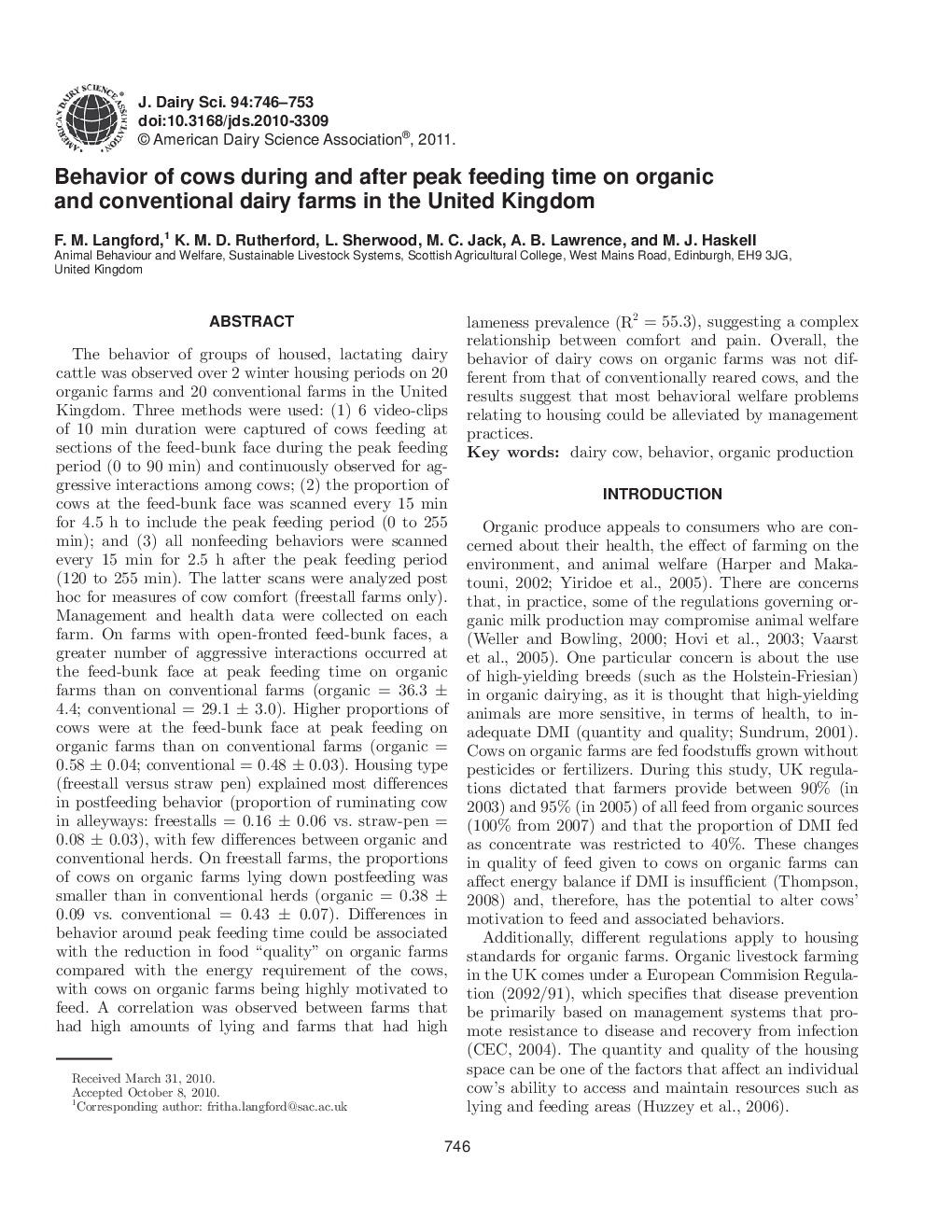| کد مقاله | کد نشریه | سال انتشار | مقاله انگلیسی | نسخه تمام متن |
|---|---|---|---|---|
| 10980048 | 1108068 | 2011 | 8 صفحه PDF | دانلود رایگان |
عنوان انگلیسی مقاله ISI
Behavior of cows during and after peak feeding time on organic and conventional dairy farms in the United Kingdom
دانلود مقاله + سفارش ترجمه
دانلود مقاله ISI انگلیسی
رایگان برای ایرانیان
موضوعات مرتبط
علوم زیستی و بیوفناوری
علوم کشاورزی و بیولوژیک
علوم دامی و جانورشناسی
پیش نمایش صفحه اول مقاله

چکیده انگلیسی
The behavior of groups of housed, lactating dairy cattle was observed over 2 winter housing periods on 20 organic farms and 20 conventional farms in the United Kingdom. Three methods were used: (1) 6 video-clips of 10 min duration were captured of cows feeding at sections of the feed-bunk face during the peak feeding period (0 to 90 min) and continuously observed for aggressive interactions among cows; (2) the proportion of cows at the feed-bunk face was scanned every 15 min for 4.5 h to include the peak feeding period (0 to 255 min); and (3) all nonfeeding behaviors were scanned every 15 min for 2.5 h after the peak feeding period (120 to 255 min). The latter scans were analyzed post hoc for measures of cow comfort (freestall farms only). Management and health data were collected on each farm. On farms with open-fronted feed-bunk faces, a greater number of aggressive interactions occurred at the feed-bunk face at peak feeding time on organic farms than on conventional farms (organic = 36.3 ± 4.4; conventional = 29.1 ± 3.0). Higher proportions of cows were at the feed-bunk face at peak feeding on organic farms than on conventional farms (organic = 0.58 ± 0.04; conventional = 0.48 ± 0.03). Housing type (freestall versus straw pen) explained most differences in postfeeding behavior (proportion of ruminating cow in alleyways: freestalls = 0.16 ± 0.06 vs. straw-pen = 0.08 ± 0.03), with few differences between organic and conventional herds. On freestall farms, the proportions of cows on organic farms lying down postfeeding was smaller than in conventional herds (organic = 0.38 ± 0.09 vs. conventional = 0.43 ± 0.07). Differences in behavior around peak feeding time could be associated with the reduction in food “quality” on organic farms compared with the energy requirement of the cows, with cows on organic farms being highly motivated to feed. A correlation was observed between farms that had high amounts of lying and farms that had high lameness prevalence (R2 = 55.3), suggesting a complex relationship between comfort and pain. Overall, the behavior of dairy cows on organic farms was not different from that of conventionally reared cows, and the results suggest that most behavioral welfare problems relating to housing could be alleviated by management practices.
ناشر
Database: Elsevier - ScienceDirect (ساینس دایرکت)
Journal: Journal of Dairy Science - Volume 94, Issue 2, February 2011, Pages 746-753
Journal: Journal of Dairy Science - Volume 94, Issue 2, February 2011, Pages 746-753
نویسندگان
F.M. Langford, K.M.D. Rutherford, L. Sherwood, M.C. Jack, A.B. Lawrence, M.J. Haskell,